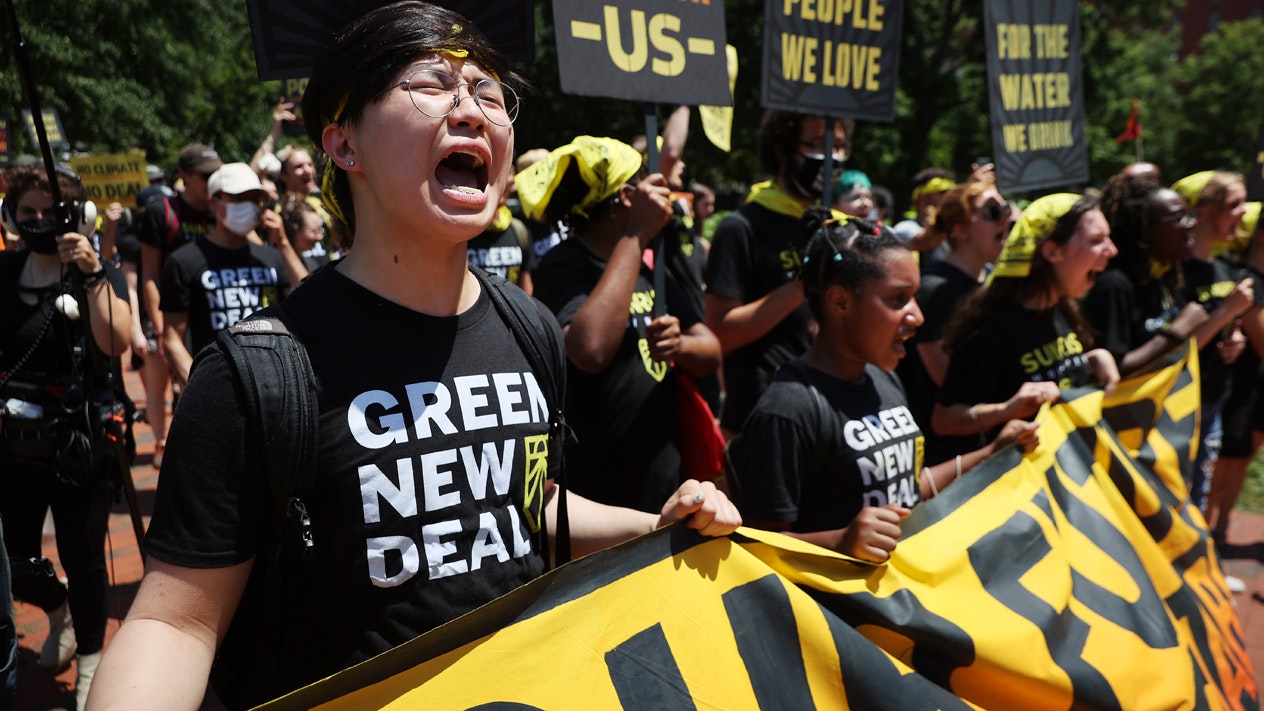Nearly two dozen states have some form of target to eliminate the use of fossil fuels in electricity generation. As more states try to increase the amount of power they get from wind, solar and batteries, electricity prices continue to climb and reliability issues mount whenever demand for energy is high.
“I don’t know what they’re planning to do. I swear to God, we’re winging this,” Kevin Kilty, a retired University of Wyoming adjunct professor of engineering, told Cowboy State Daily.
Shared Burdens
While Wyoming isn’t likely to make 100% renewable energy commitments, it won’t escape the impacts of other states’ renewable ambitions. The interconnectedness of the Western grid will mean the burden of these commitments will be shared by all states.
In the West, California, Oregon, Washington, Colorado, Nevada and New Mexico have commitments to go carbon free sometime before 2050.
California was the earliest adopter in the U.S. of carbon-free electricity targets and became a model that all the other states have followed.
After four years of an aggressive pursuit of eliminating fossil fuels, that state has the highest electricity prices in the nation after Hawaii and Alaska, according to the Energy Information Administration. That’s in addition to facing regular blackouts during times of peak demand.
Germany, which has been a world leader in the pursuit of renewable energy, is in the midst of an energy crisis. The nation’s industries are shutting down and many residents have trouble paying their bills.
“Forcing a transition to renewable energy hasn’t worked anywhere it has been tried. One only has to look at the European Union to see a perfect example of failure,” Rick Whitbeck, Alaska state director for Power The Future, told Cowboy State Daily.
Carbon-Free Costs
The latest to join the list of 100% commitments was Minnesota, which passed a law this month requiring electric utilities to get all of the electricity it sells from carbon-free sources by 2040.
Less than a week later, New Jersey Gov. Phil Murphy bumped up his state’s commitment to go carbon free in its power sector by 2035, 15 years sooner than the previous target.
Isaac Orr, policy fellow for energy and environmental policy at the Center of the American Experiment (CAE), is co-author on a study on what Minnesota’s commitment will cost the state. He testified before the Minnesota Legislature, warning the state’s lawmakers about the consequences of 100% intermittent energy from the wind and sun.
Orr has written numerous articles about electricity policy, as well as hydraulic fracturing and frac sand mining used in oil and gas production, which have appeared in The Wall Street Journal, USA Today, The New York Post, The Hill, Orange County Register and The Washington Times, among others.
Compared to operating the current grid as it is, the CAE study found, Minnesota families and businesses will pay $313 billion through 2050. This includes the average household’s electricity costs rising by an average of $3,888 per year. About 79,000 jobs will be lost, and the state’s annual gross domestic product will be reduced by $13.27 billion each year.
Minnesota will experience a 55-hour blackout in late January because of a lack of generation resources during high demand.
Defying Physics
Orr told Cowboy State Daily that Minnesota has a culture that tends to believe it can make things work even if the same thing doesn’t work anywhere else. So the experiences in Germany and California don’t dissuade the state from its renewable energy targets.
“Unfortunately, Minnesota can’t defy physics. And that’s essentially what the Legislature is attempting to do right now,” Orr said. “They’re trying to get it to where we are dependent on intermittent sources of electricity and battery storage that does not exist to meet our 24-hours 365 energy needs.”
The CAE study compared the 100% renewable energy plan with the cost of a decarbonization energy portfolio which in some ways mirrors Wyoming’s energy future. It includes decarbonizing 98% of the Minnesota electricity grid with nuclear energy and fitting coal-fired electricity plants with carbon capture. It also calls for the use of hydroelectric and battery storage.
This scenario would cost $224 billion less than the 100% renewable plan. It wouldn’t cause increased blackouts. It would cause higher electricity costs, but not nearly as high as a grid running entirely on wind, solar and batteries.
However, the study notes, both proposals reduce emissions at a cost that is higher than the Social Cost of Carbon estimates, which were created under the Obama administration as a means of determining the impacts of carbon dioxide emissions.
In other words, the study found that Minnesotans would most benefit from doing what they’re doing.
Intermittent Problems
Minnesota is served by the Midcontinent Independent System Operator (MISO) grid, which serves about a dozen states through the Mississippi River region of the United States and about two-thirds of the power for that grid comes from natural gas and coal.
Most states are served by grids connected across multiple states, which means 100% wind and solar targets will impact neighboring states in many cases.
As Minnesota moves to shut down its existing coal plants, it’s going to become a net importer of electricity, Orr said. Now, MISO has a 1,200-megawatt capacity shortfall, meaning it doesn’t have enough electricity generation online to meet peak demand, with a good margin of safety.
“So in the future, Minnesota’s policy is going to make us more dependent on the reliable power plants in other states. If the wind isn’t blowing or the sun isn’t shining, then we’re going to have problems essentially,” Orr said.
Utility Plans
Much of Wyoming is served by the Western Power Pool (WPP), and a small area of eastern Wyoming is served by the Southwest Power Pool (SPP).
In its 2022 Long-Term Reliability Assessment, the North American Electric Reliability Corp., a nonprofit international regulatory authority that is tasked with assuring the reliability of the grid, determined that both the SPP and WPP have an elevated risk for resource inadequacy, meaning that the ability for generation sources to meet electricity demand during peak demand periods, with a good margin of safety, is not very high.
Kilty, a retired engineering professor, said that even though states like Idaho, Utah and Wyoming aren’t jumping on the 100% renewable target bandwagon, utilities are laying out plans that pursue increasing amounts of intermittent wind and solar.
Public utilities file Integrated Resource Plans (IRP) with their state’s public service commissions. These identify the preferred mix of resources that will meet projected demand, maintain grid reliability and resource diversity, at the least possible costs.
Through The Night
This includes utilities operating in Wyoming.
PacifiCorp’s IRP has a target of 69% reduction in greenhouse gas emissions from 2005 levels by 2030. This includes 5,628 MW of new solar resources, 3,628 MW of new wind resources, 6,181 MW of storage resources, including battery storage co-located with solar, as well as standalone battery storage and pumped hydro storage resources.
Wyoming homes, according to the EIA, consumed roughly 15 terawatt hours in 2020, which means the battery storage won’t provide more than a few hours of energy to Wyoming homes and businesses.
Kilty said that Idaho utilities’ IRPs have similar plans for battery storage that will last a matter of hours, and the battery facilities have to be replaced about every decade.
“Eight hours worth of batteries isn’t gonna get you through at night when the wind isn’t blowing,” Kilty said.
National Wind Droughts
Kilty said the planners are expecting that they can shuttle wind and solar resources all over the grid, meaning that if a state needs power, it can import it from a state that’s producing power.
This will be very expensive.
“One of the problems with going to 100% carbon-free and relying largely on wind, solar and battery storage is that you need to overbuild the grid by a factor of about seven in order to have enough electricity when the wind isn’t blowing and the sun isn’t shining,” Orr said.
Kilty said that even with adequate wind resources spread out over the entire West, you can still end up with wind droughts that cover much of the nation.
“I’ve gotten some weather maps that I keep from time to time that show wind drops across all of North America. The entirety of the continent is quiet. It’s like many people are banking on the fact that there’s going to be surplus wind somewhere, and they can get hold of it,” Kilty said.
Finding The Threshold
While many states are pursuing these targets, none are even close to achieving them. If Europe is any indication, problems will mount as states carry out their 100% renewable energy goals.
Paul Bonifas, director of operations for 9H Research Foundation, and Tim Considine, professor of economics with the School of Energy Resources at the University of Wyoming, wrote an article on the challenges of reaching 100% renewable energy.
In “The Limits of Green Energy,” Bonifas and Considing write that “the consensus is that grid instability and power cost increases will occur as renewable penetration increases, though there is no consensus on what level of renewable penetration will be the threshold of serious problems.”
That consensus might have to wait until the nation faces those serious problems.
“Taking traditional energy sources out of play, and replacing them with higher-cost, less-reliable alternatives isn’t smart public policy. We’ve seen what happens when electric grids can’t keep up with demand because of an adherence to those solutions. It isn’t good, and it isn’t wise for states to continue down this path,” Whitbeck said.





